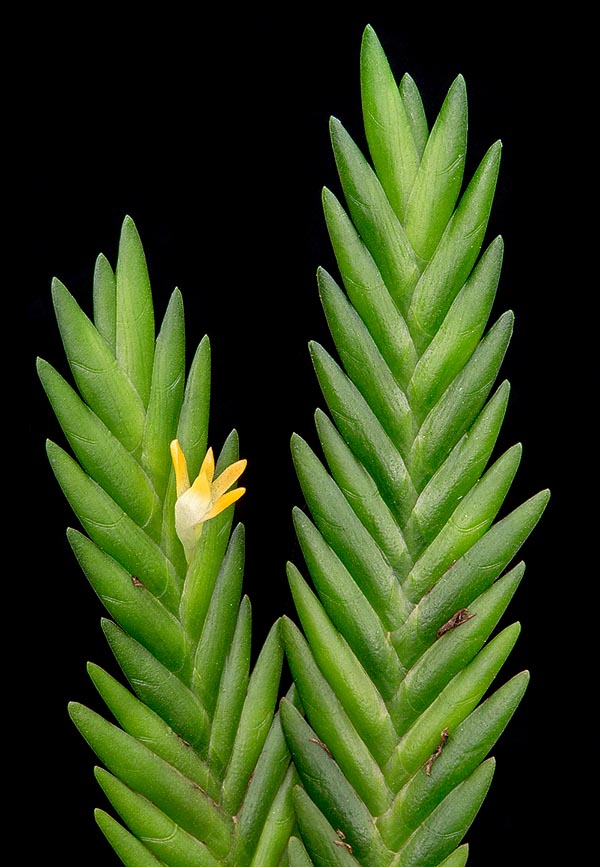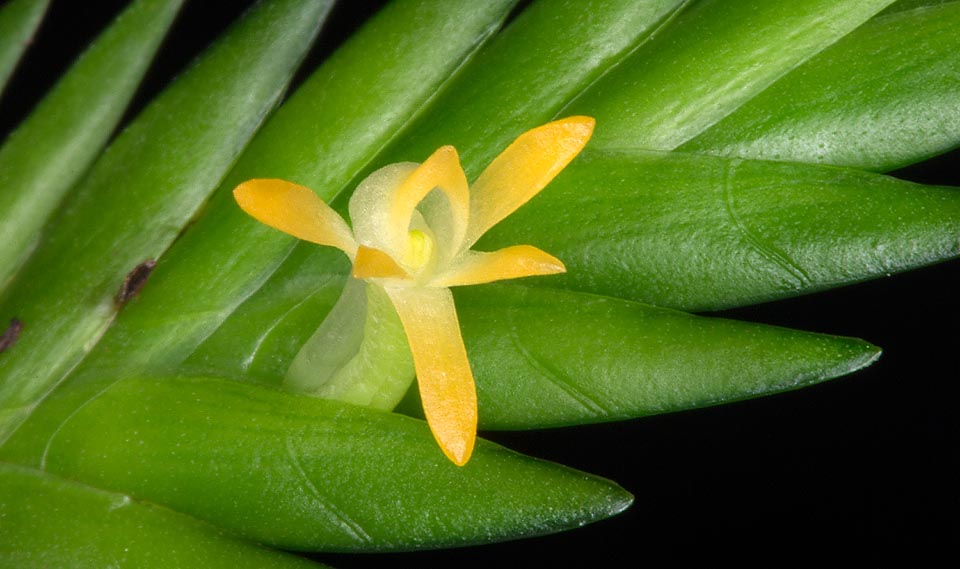Family : Orchidaceae

Text © Pietro Puccio

English translation by Mario Beltramini

The Angraecum podochiloides is a an epiphyte of tropical Central-West Africa © Giuseppe Mazza
The specis is native to tropical West Africa (Cameroon, Democratic Republic of the Congo, Equatorial Guinea, Gabon, Ghana, Ivory Coast, Liberia and Nigeria) where it grows as epiphyte on the trees of the dense humid forests at low and medium altitudes.
The name of the genus comes from the Malay one, “angurek”, utilized for epiphytic orchids; the name of the species is that of the genus Podochilus Blume with the Greek suffix “-οειδής” (-oeidés), from “εἶδος“ (êidos) = shape, look, hence similar.
The Angraecum podochiloides Schltr. (1906) is an epiphytic species with thin stems drooping or curved upward, little ramified, up to 60 cm long, provided for all their length of numerous alternate leaves, distichous, imbricate, equitant (having only one face with two-folded lamina along the central vein), falcate-lanceolate, 1,3-2 cm long and 2-4 mm broad, fleshy, of dark green colour.
Subsessile inflorescence opposite to the leaves carrying only one yellowish white, delicate, flower. Oblong-lanceolate sepals with obtuse apex, 3,5-5 mm long, linear petals with subacute apex, falcate, 3,5-4,5 mm long and about 1 mm broad, oblong-ovate labellum with curved acuminate apex, concave, 4-5 mm long and broad, provided at the base of a conical, 6 mm long, spur; cylindrical subsessile ovary, acute, 3-7 mm long.
It reproduces by seed, in vitro, and at amateur level by division. Miniature orchid with characteristic foliage quite rare in cultivation, requires a shady position, average high temperatures, 20-30 °C, with lowest ones of not less than 16 °C, high and constant humidity, 75-85%, and air in continuous and light movement. Regular and abundant waterings during the growth period, more spaced during the vegetative rest, but without leaving it to dry up completely, utilizing rain water, by reverse osmosis or demineralized.
Nebulizations in the morning with water at ambient temperature in presence of high temperatures and air with insufficient humidity. Usually, is mounted on trunks, bark, rafts of cork or of arborescent ferns roots with a layer of sphagnum at the base to maintain the humidity, can be also cultivated in pots or suspended baskets utilizing a compost based on medium sliced bark fragments with addition of inerts to improve the drainage and favour the passage of the air around the roots.

The little ramified stems touch 60 cm, curved or drooping under the weight of very decorative imbricate fleshy leaves. The small flowers, isolated, do not surpass 1 cm © Giuseppe Mazza
The species is reported in the appendix II of CITES (species whose trade is internationally ruled).
Synonyms: Monixus aporum Finet (1907); Dolabrifolia podochiloides (Schltr.) Szlach. & Romowicz (2007).
